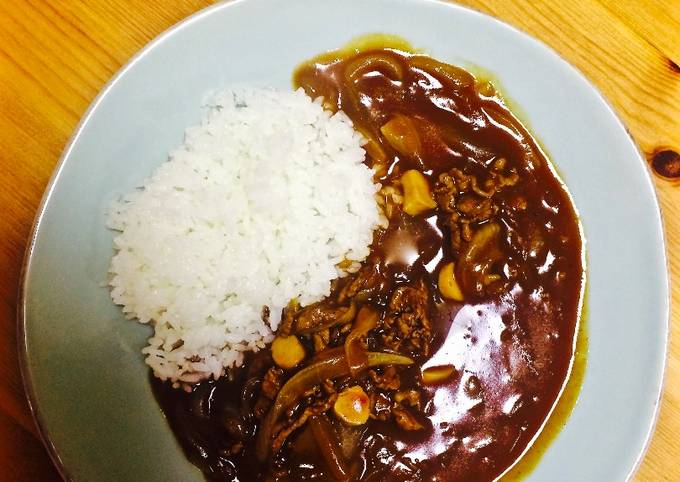Easiest Way to Prepare Award-winning Classic Hayashi Rice
Classic Hayashi Rice. Hayashi Rice, or sometimes called Hashed Beef, is a popular Western-style stew made with tender Espagnole sauce (or sometimes called brown sauce) is a classic brown sauce made from the stock. Hayashi rice or Hashed beef rice (ハヤシライス) is a dish popular in Japan as a Western-style dish or yōshoku. It usually contains beef, onions, and button mushrooms, in a thick demi-glace sauce which often contains red wine and tomato sauce.
 See recipes for Japanese Style Hushed Beef on Rice (Hayashi Rice) too. • Hayashi Rice is Japanese beef stew poured over Steamed Rice. Hayashi sauce has distinct flavors of demi-glace brown sauce and red wine. It has been a popular western style Japanese dish since the.
See recipes for Japanese Style Hushed Beef on Rice (Hayashi Rice) too. • Hayashi Rice is Japanese beef stew poured over Steamed Rice. Hayashi sauce has distinct flavors of demi-glace brown sauce and red wine. It has been a popular western style Japanese dish since the.
Hello everybody, it's me again, Dan, welcome to our recipe page. Today, I'm gonna show you how to make a special dish, classic hayashi rice. One of my favorites food recipes. This time, I'm gonna make it a bit unique. This is gonna smell and look delicious.
Classic Hayashi Rice is one of the most popular of recent trending foods in the world. It is simple, it is fast, it tastes delicious. It's appreciated by millions daily. They are fine and they look wonderful. Classic Hayashi Rice is something which I have loved my entire life.
Hayashi Rice, or sometimes called Hashed Beef, is a popular Western-style stew made with tender Espagnole sauce (or sometimes called brown sauce) is a classic brown sauce made from the stock. Hayashi rice or Hashed beef rice (ハヤシライス) is a dish popular in Japan as a Western-style dish or yōshoku. It usually contains beef, onions, and button mushrooms, in a thick demi-glace sauce which often contains red wine and tomato sauce.
To begin with this recipe, we must first prepare a few components. You can have classic hayashi rice using 8 ingredients and 6 steps. Here is how you cook that.
The ingredients needed to make Classic Hayashi Rice:
- {Make ready 300 g of Thinly sliced beef.
- {Make ready 2 of Medium onions(Sliced).
- {Take 200 g of Mushrooms (Any kind).
- {Make ready 1 Box of Hayashi Paste.
- {Take 700 ml of Water.
- {Get 100 ml of Red wine.
- {Take 1 Tbsp of Worcestershire sauce.
- {Make ready 1 Tbsp of Milk.
Hayashi rice or hashed beef rice is a Japanese dish consisting of a beef stew with a demi-glace base that is poured over steamed rice. It is a western-style Japanese dish that has been popular since the. Hayashi rice is made with a dark brown roux, which adds toasty flavor but requires constant vigilance to avoid burning. Home cooks may use instant roux blocks to simplify this process.
Steps to make Classic Hayashi Rice:
- Heat olive oil in a large deep pan and stir-fry the sliced onions. Keep cooking till it gets soft and brown..
- Add beef and mushroom. Keep stir-frying until beef is cooked..
- Pour in water and bring to boil. Skim off the foam(scum). Simmer for about 10-15 minutes..
- Reduce heat, add the Hayashi paste and stir well until the paste melts down..
- Add red wine, worcestershire sauce, and milk. Simmer gently for about 5-10 minutes..
- Serve with rice. Tasty with salad on the side!.
Hayashi raisu (rice) is a western style (yoshoku) Japanese beef stew. A classic dish, second only to curry, this dish is derived from the word "hashed", or hashed beef. Hayashi rice is a classic Western-style (yōshoku) comfort food in Japan that is popular among both adults and children. It's traditionally made with caramelized onions, beef and mushrooms stewed in a. Hayashi rice stew is a Japanese food/dish inspired by beef stews in Western cuisines.
So that's going to wrap this up with this special food classic hayashi rice recipe. Thank you very much for your time. I'm sure you can make this at home. There's gonna be more interesting food in home recipes coming up. Don't forget to save this page in your browser, and share it to your loved ones, colleague and friends. Thanks again for reading. Go on get cooking!